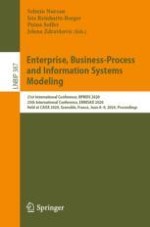This book contains the proceedings of two long-running events held along with the CAiSE conference relating to the areas of enterprise, business-process and information systems modeling:
* the 21st International Conference on Business Process Modeling, Development and Support, BPMDS 2020, and
* the 25th International Conference on Exploring Modeling Methods for Systems Analysis and Development, EMMSAD 2020.
The conferences were planned to take place in Grenoble, France, during June 8–9, 2020. They were held virtually due to the COVID-19 pandemic.
For BPMDS 13 full papers and 1 short paper were carefully reviewed and selected for publication from a total of 30 submissions; for EMMSAD 11 full papers and 4 short papers were accepted from 29 submissions.
The papers were organized in topical sections named as follows:
BPMDS: Business process execution and monitoring, BPM applications in industry and practice, planning and scheduling in business processes, process mining, process models and visualizations
EMMSAD: Requirements and method engineering, enterprise and business modeling, software-related modeling, domain-specific modeling, evaluation-related research.
